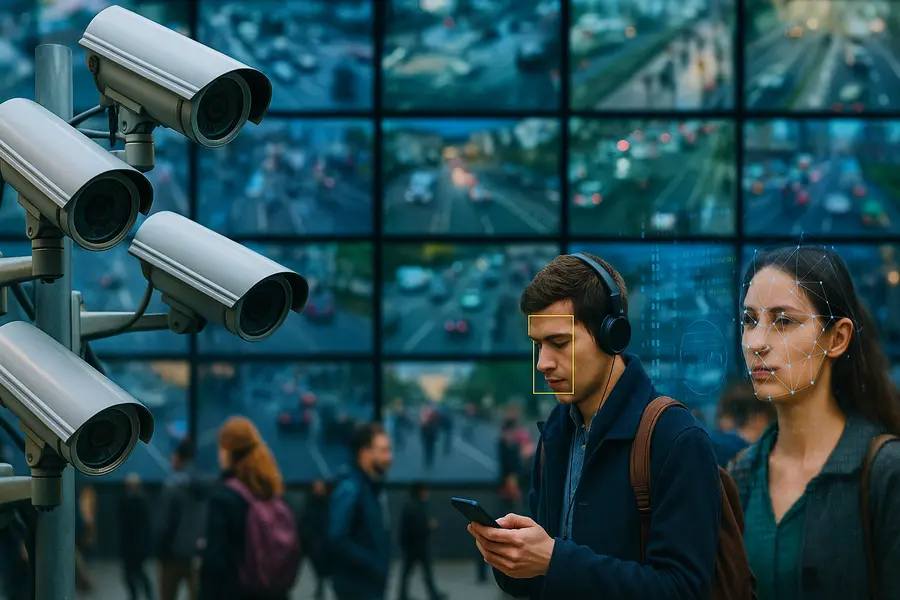The Rise of Surveillance Culture in Digital Societies: A Sociological Analysis
Surveillance culture is no longer a distant concept—it’s woven into our everyday lives in digital societies.
From CCTV cameras on every street corner to invisible web trackers that follow our clicks, data collection has become the norm.
Governments and corporations deploy facial recognition, biometric scanners, and AI-powered monitoring tools, promising security and convenience. But at what cost to personal privacy?
This surge in digital surveillance reshapes how we work, interact, and even think, often triggering self-censorship and eroding trust.
Recent studies reveal billions of stored video feeds and frequent data breaches, underscoring the vulnerability of our personal information.
As we navigate a world where every movement and online action can be recorded, it’s urgent to understand how surveillance culture affects our rights and freedoms—and what steps we can take to protect our privacy.
Let’s dig into this pressing issue together.

Exploring the Rise of Surveillance Culture in Digital Societies and Its Impact on Privacy and Trust
In our increasingly connected world, surveillance culture has crept into nearly every corner of daily life.
From government-operated CCTV networks to the countless trackers embedded on the websites we visit, surveillance has become normalized as a trade-off for convenience, security, or entertainment. Yet, this normalization raises critical questions about personal autonomy and the boundaries of privacy.
As Kate Wagner argues in her recent critique of “kiss-cam” culture at a Coldplay concert, the impulse to broadcast private moments speaks to a deeper societal shift toward exposure and public shaming.
Freedom House’s annual Freedom on the Net report further highlights how digital surveillance practices—from content blocking to data retention laws—are reshaping online freedoms across the globe.
The global sales of home security cameras topped $9.7 billion in 2023, proof that people want safety even if it means more eyes on them.
This introduction sets the stage: surveillance offers promise of security and convenience, but at what cost to our freedom and autonomy?
In this article, we’ll explore how surveillance culture has evolved, how it impacts trust, and what data breaches and regulations tell us about our future.
Historical Evolution of Surveillance Culture
Surveillance began as a tool for law enforcement—CCTV cameras installed in the 1940s mainly to observe public spaces for crime prevention.
But by 2021, there were an estimated 1 billion surveillance cameras worldwide, with 700 million alone in China’s “SkyNet” program.
As camera costs plunged and storage became cheaper, governments and businesses snapped up video feeds by the millions.
At the same time, the internet’s rise spawned invisible watchers—cookies and web beacons that tracked pages visited, items clicked, and time spent on each screen.
What started out as crime deterrence turned into data commodification: every recorded scene or logged click became a data point to analyze.
In this historical sweep, convenience and security drove adoption, even as the line between watching for safety and watching for control blurred.
Today’s challenge is recognizing that surveillance tools, once benign, can be repurposed to influence behavior, manipulate opinions, or chill dissent—even in open societies.
The Commercial Surveillance Boom
Commercial surveillance has exploded beyond street-corner cameras. In 2023, global revenue from home video surveillance devices soared past $9.7 billion, a sign that homeowners embrace technology to feel safer—even if it means recording themselves and guests.
Tech firms know this too: Ring, Nest, and dozens of startups flood the market with doorbells, baby monitors, and AI-enabled cameras boasting features like package detection, pet alerts, and facial recognition.
Meanwhile, digital advertising relies on trackers embedded in apps and websites: a 2024 report found the average smartphone app contacts five different ad trackers within the first minute of use.
Companies argue these tools help personalize services and keep platforms free. But the trade-off is immense data collection: every movement, voice snippet, and behavioral pattern can be logged and monetized.
As the commercial surveillance market grows toward a projected $24 billion by 2030, consumers must ask whether the extra insight into their lives is worth the creeping loss of control.
Corporate Trackers and Data Harvesting
Beyond visible cameras, an invisible network of trackers harvests your clicks, scrolls, and location pings.
In a 2023 study across Latin American websites, Google Display & Video 360 accounted for 20.1% of all detected trackers, with Google Analytics close behind at 14.9%. These tools assemble detailed profiles—your interests, shopping habits, travel plans—that advertisers and data brokers buy and sell.
Privacy International’s 2023 report highlights that most users remain oblivious to this ecosystem: 67% of people admit they don’t fully understand how their data is collected online.
Even worse, many “privacy settings” do little to stop data flows, as trackers migrate to apps and new protocols. The result is a surveillance net so fine that it can predict personality traits, political leanings, and even creditworthiness—all without explicit consent.
As corporate trackers spread into connected cars and smart TVs, our digital footprint grows heavier, raising pressing questions about data ownership and the true cost of “free” services.
Emerging Biometric Surveillance: Wi-Fi Fingerprinting
Biometrics once meant fingerprints or iris scans; emerging methods tap into our wireless signals.
Researchers at La Sapienza University introduced “WhoFi,” a system that analyzes how a person’s body disrupts Wi-Fi signals to create a unique “fingerprint” with 95.5% accuracy—even through walls and in total darkness.
This covert technique requires no camera or direct interaction: any Wi-Fi router can become a surveillance node.
Meanwhile, gait-analysis firms claim they can identify people by how they walk, using just a few seconds of video.
As these technologies mature, traditional privacy measures—blinds, encryption, VPNs—won’t suffice.
The idea of “going off the grid” loses meaning when your body’s physical signature becomes trackable.
Beyond law enforcement, employers and landlords could deploy such systems to monitor behavior without consent.
Biometric advances promise security boosts, like identifying unauthorized visitors, but they also blur ethical lines: who owns your biometric data, and how long does a digital fingerprint live?
State Surveillance and Censorship
Governments worldwide have ramped up digital surveillance under the banner of national security and public order.
According to Freedom House’s “Tunnel Vision” report, 21 out of 72 countries recently blocked anti-censorship tools—VPNs and Tor networks—cutting off citizens’ ability to bypass firewalls.
In some cases, facial-recognition cameras feed directly into police databases, flagging “persons of interest” in real time.
Data-retention laws force ISPs to store user metadata—time, location, and recipient of communications—for months or years.
Such mandates can infringe on human rights: journalists in tightly controlled states face arrest simply for visiting banned websites.
Even democratic nations have adopted troubling measures, collecting bulk phone and internet records without warrants.
While proponents argue these tools foil terrorism and crime, unchecked powers risk chilling free speech, dissent, and open debate.
The balance between security and liberty grows more tenuous as software backdoors, real-time monitoring, and censorship mesh into a single apparatus.
Privacy, Trust, and Self-Censorship
Knowing someone’s watching changes how we behave—a phenomenon researchers call the “chilling effect.”
A recent interdisciplinary review on post-COVID health surveillance found that 62% of people hesitated to seek medical care or discuss symptoms online, fearing data might be used against them later.
Trust in institutions—government, healthcare, tech companies—has eroded: only 28% of adults in one global survey say they fully trust public health agencies with their personal data.
Online, users self-censor comments on social media, delete search histories, or avoid “sensitive” topics altogether. This impacts democracy: citizens may shy away from participating in policy debates or marginalized groups may stay silent rather than risk exposure.
The paradox is clear: surveillance implemented to protect public welfare can undermine that very welfare by sowing fear.
Restoring trust requires transparency about data use, robust consent mechanisms, and clear limits on how long personal information remains in private or public databases.
The Rise in Data Breaches
As surveillance collects ever more data, organizations struggle to keep it safe.
Verizon’s 2023 Data Breach Investigations Report shows 83% of breaches had a financial motive, with human error or phishing involved in 74% of incidents.
Cloud environments, once hailed as secure, aren’t immune: Thales’ 2023 Cloud Security Report found 39% of businesses experienced a cloud data breach, up from 35% in 2022.
Even basic misconfigurations—public storage buckets, outdated software—lead to mass exposures. Each breach leaks personal emails, health records, financial details, or surveillance footage, eroding user trust. Individuals face increased identity theft and targeted scams; companies face fines and brand damage.
The irony is stark: surveillance is deployed to enhance safety, yet the data it gathers often ends up in the hands of cybercriminals.
As breaches climb, organizations must invest in robust cybersecurity training, multi-factor authentication, and zero-trust architectures to protect the very information they collect.
Massive Breaches and Supply-Chain Vulnerabilities
High-profile supply-chain attacks underscore systemic risk. In May 2023, the MOVEit file-transfer vulnerability let the Cl0p ransomware gang siphon data from over 2,700 organizations, affecting 93.3 million individuals across sectors: media, healthcare, and government.
That same year, the “Mother of All Breaches” exposed 26 billion records—login credentials, email addresses, and even personal identifiers—pulled from leaks at Twitter, Adobe, LinkedIn, and more. Such incidents show that even if your favorite app is secure, its partners might not be.
Cybercriminals now target software vendors as a gateway to multiple victims.
For users, supply-chain breaches can mean widespread password reuse attacks, phishing campaigns, and identity theft waves.
Companies must vet third-party vendors rigorously, implement strict access controls, and monitor unusual data flows.
Regulators are catching up: new rules in the EU and U.S. require greater supply-chain transparency, but enforcement remains patchy.
Until standards improve, every connection becomes a potential entry point for mass surveillance—and mass exposure.
Genetic Data Under Threat: The 23andMe Case
Genetic testing seemed like the ultimate in personal insight; now it’s another data trove at risk.
In February 2025, credential-stuffing attacks compromised 5.5 million 23andMe accounts, exposing raw genetic profiles and health predispositions. Because users often reuse passwords, attackers could access sensitive lineage and medical information—details that never change and can’t be “re-set.”
The breach highlights two issues: genetic data’s permanence and the insufficiency of basic security measures like passwords alone.
Consumers traded privacy for ancestry reports, not expecting their DNA to become a commodity on the dark web.
The fallout? Heightened regulatory scrutiny and calls for stricter encryption and multi-factor authentication from biotech firms.
Genetic data, once siloed in research labs, now sits in cloud databases vulnerable to breach.
Protecting it demands specialized safeguards: hashed and salted storage, zero-knowledge proofs, and clear consent protocols for sharing or secondary use.
Surveillance Culture and Intimate Relationships
Surveillance culture isn’t just top-down—partners and family members deploy it too.
An Australian eSafety Commission survey found that 1 in 5 young people believe using location-tracking apps on a partner is acceptable if framed as “care.”
Apps marketed for child monitoring or pet trackers are repurposed to stalk spouses or exes.
GPS pings, hidden cameras, and shared passwords create a digital leash that can trap victims in cycles of control.
Technology exacerbates domestic abuse, turning smartphones into surveillance hubs.
Victims often hesitate to seek help, fearing devices will reveal their plans or whereabouts.
Advocacy groups now push for “tech safety” education: how to recognize stalking apps, secure devices, and build digital boundaries.
Lawmakers are responding in kind—several U.S. states have passed laws making non-consensual tracking a criminal offense.
Still, intimate surveillance thrives in the shadows, reminding us that privacy violations begin at home as much as in corporate boardrooms.
Public Attitudes Toward Privacy
Despite daily surveillance, people care about privacy—at least in theory. 74% worry about privacy threats; 29% faced serious data breaches; 65% feel more concerned now than five years ago.
A Pew Research Center survey found that 56% of Americans often click “Agree” on privacy policies without reading them, yet 69% view those policies as mere hurdles rather than genuine transparency measures. Likewise, 71% worry about how governments use collected data, up from 64% in 2019.
Globally, similar trends emerge: a Cisco study reports 84% of consumers value data privacy, but only 44% trust companies to safeguard their information. This gap between attitude and action—sometimes called the “privacy paradox”—reflects limited alternatives and feature trade-offs.
Users crave personalized services but balk at invasive data practices. As public awareness grows, so does demand for better tools: encrypted messaging soared by 120% in 2023, and privacy-first search engines saw user bases double.
Companies that prioritize clear, jargon-free policies and genuine consent stand to gain trust—and market share—in an era where consumers finally recognize the value of their own data.
Calls for Stronger Regulation
Public pressure is driving new laws. In the U.S., 72% of adults support tougher oversight of corporate data practices, with only 7% opposed.
The EU’s GDPR set the bar in 2018, imposing fines up to 4% of global revenue for data-handling violations.
California followed with the CCPA, granting consumers rights to access, delete, and opt out of data sales. Now, the EU’s NIS2 and DORA directives aim to tighten rules around critical infrastructure and digital resilience, covering sectors from finance to healthcare.
In Asia, India’s proposed Personal Data Protection Bill promises stricter controls on cross-border data flows. Yet enforcement remains uneven: only 10% of GDPR fines issued so far exceed $1 million, and many smaller companies fly under regulators’ radars.
Effective regulation needs consistent enforcement, clear guidelines for emerging tech like AI, and mechanisms that empower individuals to assert their rights without legal aid.
The Financial Toll of Surveillance and Breaches
Surveillance infrastructure and subsequent breaches carry hefty price tags.
IBM’s 2025 Cost of a Data Breach Report pegs the global average breach cost at $4.4 million, down slightly thanks to faster detection, but still substantial.
Ransomware attacks hit 72.7% of organizations in 2023, with average ransom demands rising to $812,000.
Beyond direct losses—ransom payments, remediation, legal fees—companies face brand damage, lost customers, and regulatory fines.
On the surveillance side, installing and maintaining camera networks, analytics software, and data centers can cost midsize cities $5–10 million annually.
Private businesses and homeowners spend billions more. Ironically, the very technologies touted to enhance security end up requiring ever-greater investment to defend against misuse and attack.
As budgets tighten, organizations must weigh the marginal security benefits of new surveillance tools against the long-term costs of data management and cyber resilience.
Cybercrime and National Security
Digital surveillance and cybercrime intersect at the national-security frontier.
A Financial Times analysis reports 94% of IT leaders faced significant cyber attacks in 2023, pushing global cybersecurity spending toward $9.5 trillion by 2024.
State actors and criminal syndicates exploit surveillance infrastructures for espionage, disinformation, and infrastructure sabotage.
Supply-chain attacks on critical systems—from power grids to hospital networks—pose existential threats. In response, governments are forging cyber alliances and enforcing stricter export controls on surveillance tech.
The U.S. recently blacklisted several AI-powered surveillance firms over human-rights concerns.
NATO members now conduct joint cyber drills simulating mass-surveillance failure scenarios. Still, talent shortages and fragmented regulations hamper coordinated defense.
As surveillance tools become dual-use—capable of guarding borders or undermining elections—nations find themselves in a high-stakes arms race where data is both weapon and target.
Read Here: Cybercrime in the Digital Age: New Threats & Prevention Tips
Balancing Security and Freedom
The central dilemma of our age: how do we use surveillance to keep us safe without trampling individual rights?
Zero-trust architectures and data-minimization principles offer technical guardrails—collect only what’s necessary, and require continuous authentication.
Policy frameworks like “privacy by design” embed civil-liberties checks into technology development. Yet even well-intentioned systems can become tools of overreach when repurposed.
Body-camera footage meant for police accountability can be used to identify bystanders or track protests.
Threat-intelligence sharing between firms can spill into consumer profiling. Effective balance demands multi-stakeholder oversight: technologists, ethicists, lawmakers, and the public must collaborate on clear red lines.
Independent privacy audits, impact assessments, and sunset clauses for data retention can ensure surveillance remains accountable.
Ultimately, freedom and security aren’t zero-sum—smart design and transparent governance can empower both.
Activism and Pushback
Civil-society groups are pushing back on surveillance overreach. Privacy International’s 2023 campaigns challenged GPS tagging of migrants and won policy changes in several European countries.
In parallel, Freedom House’s crowdsourced spyware tracker, launched in late 2024, catalogs misuse of commercial spyware against journalists and dissidents in real time.
Grassroots movements teach “tech safety” to vulnerable communities, distributing guides on detecting hidden trackers and securing devices. Even corporate employees have formed “ethical hacking” collectives to audit their employers’ products.
At the legal level, class actions against big tech over facial-recognition misuse are gaining traction, with multimillion-dollar settlements forcing companies to curb reckless data practices. These efforts show that public vigilance and organized resistance can shape the rules of the digital playground.
When citizens insist on transparency and accountability, surveillance culture must adapt—or face reputational and legal consequences.
The AI Surveillance Challenge
Artificial intelligence supercharges surveillance—automated face recognition, emotion detection, behavioral prediction—yet governance lags behind.
IBM’s joint study with the Ponemon Institute warns of an “AI oversight gap”: 85% of organizations deploy AI security tools without formal ethical frameworks. This mismatch risks biased targeting, opaque decision-making, and irreversible privacy harms.
For instance, predictive-policing algorithms have flagged minority neighborhoods for increased patrols, perpetuating systemic bias.
Deepfake technologies threaten to fabricate surveillance evidence, undermining trust in video proof.
Regulators are scrambling: the EU’s AI Act will classify high-risk uses, but enforcement mechanisms remain under debate.
Meanwhile, international bodies like the OECD advocate AI principles—but lack binding force. As AI-driven surveillance proliferates, we need clear rules on data governance, algorithmic transparency, and redress pathways for errors.
Without these guardrails, we risk a world where every movement, gesture, or expression becomes fodder for automated scrutiny.
Shaping a Privacy-Respecting Future
Despite the challenges, a privacy-centric future is attainable. Privacy-enhancing technologies—end-to-end encryption, homomorphic encryption, and decentralized identity—can return control to users.
Decentralized networks let individuals opt in or out of data sharing, while zero-knowledge proofs validate information without revealing raw data.
On the policy side, embedding “data dignity” principles into law would require explicit user consent for every new data use, with automatic deletion after purpose fulfillment.
Ethical design codes, taught in every computer-science curriculum, can shift developer incentives away from surveillance capitalism.
Consumer demand for private products is rising: encrypted messaging apps saw 120% growth in 2023, and privacy-first browsers and search engines doubled their user bases.
When choice and transparency become competitive advantages, both companies and governments will follow. This vision—where convenience and security coexist with respect for personal autonomy—reminds us that privacy isn’t a relic of the past but a cornerstone of a fair, free digital society.
Read Here: How Deepfake Technology Is Eroding Social Trust in Digital Age
Conclusion
Surveillance in our daily lives no longer feels like a sci-fi plot—it’s as common as checking your phone first thing in the morning.
Surveillance culture has woven itself into modern life—on our streets, in our devices, and even in our bodies.
From the humble CCTV camera to AI-powered Wi-Fi fingerprinting, each advance promises safety but treads on privacy.
We swap personal details for freebies online, wave past countless cameras on the street, and agree to tracking cookies without flinching. Yet, every click and camera feed chips away at our expectation of privacy.
Data breaches and supply-chain hacks expose the fragility of the very information we collect. Meanwhile, public concern, regulatory action, and activist pushback signal a growing demand for accountability.
The challenge ahead is crafting technologies and policies that secure communities without sundering individual freedom.
If we embrace privacy-enhancing tools, ethical design, and strong legal frameworks, we can ensure that surveillance serves society rather than spies on it.
Your data is more than a commodity—it’s part of your story. Reclaiming control means shaping a future where technology and trust walk hand in hand.
Author: Mahtab Alam Quddusi – A Passionate Writer, Blogger, Social Activist, Postgraduate in Sociology and Social sciences and Editor of The Scientific World.





